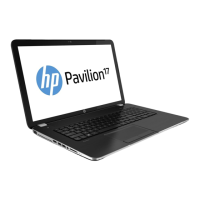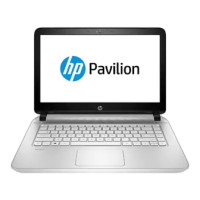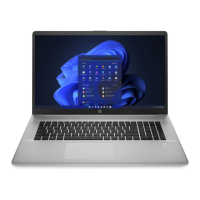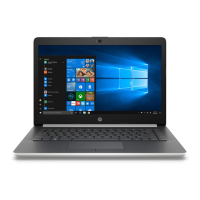NOTE: To connect a NIC to a Preboot eXecution Environment (PXE) or Remote Program Load (RPL)
server without using MultiBoot, press esc while the “Press the ESC key for Startup Menu” message is
displayed at the bottom of the screen, and then quickly press f12.
Considering boot order changes
Before changing the boot order, note the following considerations:
●
When the computer restarts after the boot order has been changed, the computer attempts to start
using the new boot order.
●
If there is more than one type of boot device, the computer attempts to boot using the first of each
type of boot device (except for optical devices). For example, if the computer is connected to an
optional docking device (select models only) that contains a hard drive, this hard drive will be shown
in the boot order as a USB hard drive. If the system attempts to boot from this USB hard drive and
fails, it will not attempt to boot to the hard drive in the hard drive bay. Instead, it will try to boot to
the next type of device in the boot order. However, if there are two optical devices, and the first
optical device does not boot (either because it does not contain media or the media is not a boot
disc), the system will try to boot to the second optical device.
●
Changing the boot order also changes the logical drive designations. For example, if you start up
from a CD-ROM drive with a disc formatted as drive C, that CD-ROM drive becomes drive C and
the hard drive in the hard drive bay becomes drive D.
●
The computer will boot from a NIC device only if the device has been enabled in the Built-In Device
Options menu of Computer Setup and if booting from the device has been enabled in the Boot
Options menu of Computer Setup. Booting from a NIC does not affect logical drive designations
because no drive letter is associated with the NIC.
●
Drives in an optional docking device (select models only) are treated like external USB devices in
the boot order.
Choosing MultiBoot preferences
You can use MultiBoot in the following ways:
●
To set a new boot order that the computer uses each time it is turned on, by changing the boot
order in Computer Setup.
●
To dynamically choose the boot device, by pressing esc while the “Press the ESC key for Startup
Menu” message is displayed at the bottom of the screen, and then pressing f9 to enter the Boot
Device Options menu.
●
To use MultiBoot Express to set variable boot orders. This feature prompts you for a boot device
each time the computer is turned on or restarted.
Setting a new boot order in Computer Setup
To start Computer Setup and set a boot device order that the computer uses each time it is turned on
or restarted, follow these steps:
1. Turn on or restart the computer, and then press esc while the “Press the ESC key for Startup Menu”
message is displayed at the bottom of the screen.
2. Press f10 to enter BIOS Setup.
3. Use a pointing device or the arrow keys to select the Legacy Boot Order list, and then press
enter.
Considering boot order changes 113

